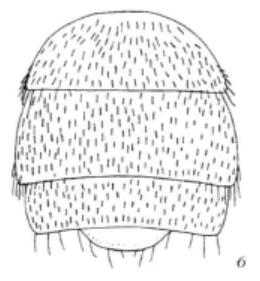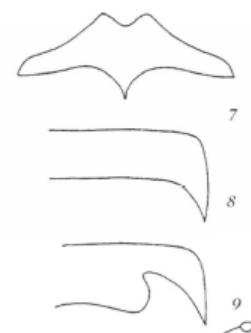Bothriomyrmex urartus
| Bothriomyrmex urartus | |
|---|---|
| Scientific classification | |
| Kingdom: | Animalia |
| Phylum: | Arthropoda |
| Class: | Insecta |
| Order: | Hymenoptera |
| Family: | Formicidae |
| Subfamily: | Dolichoderinae |
| Genus: | Bothriomyrmex |
| Species: | B. urartus |
| Binomial name | |
| Bothriomyrmex urartus Dubovikoff, 2002 | |
The species dwells in open arid biotopes, with nests built under stones. Winged queens and males were found in nests in mid-June (Dubovikoff, 2002).
Identification
Dubovikoff (2002) - Close to Bothriomyrmex communista occurring in the Crimea and western Caucasus. The new species is clearly distinguished from B. communista by the presence of short erect pubescence of the body in females and the structure of the male genitalia. Workers of these two species are poorly distinguishable (as also workers of most Bothriomyrmex species); their measurements and indices may frequently overlap.
Distribution
Distribution based on Regional Taxon Lists
Palaearctic Region: Armenia (type locality).
Distribution based on AntMaps
Distribution based on AntWeb specimens
Check data from AntWeb
Countries Occupied
| Number of countries occupied by this species based on AntWiki Regional Taxon Lists. In general, fewer countries occupied indicates a narrower range, while more countries indicates a more widespread species. |

|
Estimated Abundance
| Relative abundance based on number of AntMaps records per species (this species within the purple bar). Fewer records (to the left) indicates a less abundant/encountered species while more records (to the right) indicates more abundant/encountered species. |

|
Biology
Castes
Worker

| |
| . | |
Queen
 
| |
| . | |
Male
 
| |
| . | |
Nomenclature
The following information is derived from Barry Bolton's Online Catalogue of the Ants of the World.
- urartus. Bothriomyrmex urartus Dubovikoff, 2002: 919, figs. 4-10 (w.q.m.) ARMENIA.
- Type-material: holotype queen, 18 paratype workers, 7 paratype queens, 12 paratype males.
- Type-locality: holotype Armenia: Dzhrvezh, nr Yerevan, 19.vi.1988, no. 203-88 (A. Radchenko); paratypes: 2 workers, 1 queen, 2 males with same data, 4 workers, 4 queens, 3 males Armenia: Khosrovskii Nature Reserve, Vedi Dist., no. 242-86, 14.vi.1986 (A. Radchenko), 4 workers, 4 males as last but no. 301-86, 17.vi.1986 (Petrenko), 8 workers, 2 queens, 3 males, Armenia: Karabakhlar, Vedi, no. 1126, 17.vi.1960 (G. Dlussky).
- Type-depositories: ZISP (holotype); SIZK, ZISP, ZMUM (paratypes).
- Status as species: Seifert, 2012b: 102; Borowiec, L. 2014: 24.
- Distribution: Armenia.
Unless otherwise noted the text for the remainder of this section is reported from the publication that includes the original description.
Description
Worker
Thorax without, or, occasionally, with weakly marked metanotal depression. Head, thorax, and legs light fuscous; abdomen dark. Body with only short recumbent hairs. Chaetae present only on outer and inner margins of clypeus and outer margins of abdominal tergites. Fore coxa with two long chaetae. CI = 90-95; SI = 80-85.
Queen
Body dark fuscous; leg and antennae light fuscous. Recumbent abdominal pubesence dense everywhere (distance between hair much less than their length). Head, mesoscutum, scutellum, and abdominal tergite with short erect hair. Abdominal erect hairs present on all tergite surfaces, rather than only on their posterior margins. Declivous surface of abdominal tergite I with short erect hair. Scapus projecting beyond occipital head margin by about 1.5 scapus diameters. Cl = 91 (91); SI = 81 - 82 (81).
Male
Body dark fuscous; recumbent pubescence finer than that in queens. Erect hairs, short and not numerous, present only on ultimate abdominal tergite. Scapus short, projecting beyond outer eye margin (in front view) by about 2 scapus diameters. Subgenital plate with shallow notch; upper margin of sagitta almost right-angled. Volsella deeply notched. CI = 123-126; OI = 91.
Type Material
Holotype: Q, Armenia, environs of Yerevan, Dzhrvezh, 19.6.1988, no. 203-88, A. Radchenko (Zoological Institute of the Russian Academy of Sciences). Paratypes: Armenia: 1 Q, 2M, 2 W, labels as in holotype (ZISP); 4Q, 3M, 4W, Khosrovskii Nature Reserve, Yedi district, under stone, no. 242-86, 14.VI.1986, A. Radchenko (Institute of Zoology of the Ukranian National Academy of Sciences); 4 W, 4 M, same locality, under stone, no. 301-86, 17.VI.1986, Petrenko (ZISP); 2 Q, 3 M, 8 W, Karabakhlar, Vedi, no. 1126, 17.VI.1960, G. Dlusskii (Zoological Museum of the Moscow State University).
Etymology
The species is named after the ancient state Urartu, which existed on the territory of Armenian Upland in 9-6th centuries B. D.
Determination Clarifications
The record of Bothriomyrmex communista from Armenia (Arakelyan, 1994) should be referred to Bothriomyrmex urartus.
References
- Borowiec, L. 2014. Catalogue of ants of Europe, the Mediterranean Basin and adjacent regions (Hymenoptera: Formicidae). Genus (Wroclaw) 25(1-2): 1-340.
- Dubovikoff, D.A. 2002. New species of the ant genus Bothriomyrmex Emery, 1869 (Hymenoptera, Formicidae) from the Caucasus. Entomol. Obozr. 81:918-922. (page 919, figs. 4-10 worker, queen, male described)
References based on Global Ant Biodiversity Informatics
- Borowiec L. 2014. Catalogue of ants of Europe, the Mediterranean Basin and adjacent regions (Hymenoptera: Formicidae). Genus (Wroclaw) 25(1-2): 1-340.
- Dubovikoff D. A. 2002. New species of the ant genus Bothriomyrmex Emery, 1869 (Hymenoptera, Formicidae) from the Caucasus. Entomol. Obozr. 81: 918-922.
- Seifert B. 2012. A review of the West Palearctic species of the ant genus Bothriomyrmex Emery 1869 (Hymenoptera: Formicidae). Myrmecological News 17: 91-104.